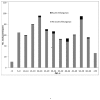Chikungunya as a cause of acute febrile illness in southern Sri Lanka
- PMID: 24312651
- PMCID: PMC3846738
- DOI: 10.1371/journal.pone.0082259
Chikungunya as a cause of acute febrile illness in southern Sri Lanka
Abstract
Background: Chikungunya virus (CHIKV) re-emerged in Sri Lanka in late 2006 after a 40-year hiatus. We sought to identify and characterize acute chikungunya infection (CHIK) in patients presenting with acute undifferentiated febrile illness in unstudied rural and semi-urban southern Sri Lanka in 2007.
Methodology/principal findings: We enrolled febrile patients ≥ 2 years of age, collected uniform epidemiologic and clinical data, and obtained serum samples for serology, virus isolation, and real-time reverse-transcriptase PCR (RT-PCR). Serology on paired acute and convalescent samples identified acute chikungunya infection in 3.5% (28/797) patients without acute dengue virus (DENV) infection, 64.3% (18/28) of which were confirmed by viral isolation and/or real-time RT-PCR. No CHIKV/DENV co-infections were detected among 54 patients with confirmed acute DENV. Sequencing of the E1 coding region of six temporally distinct CHIKV isolates (April through October 2007) showed that all isolates posessed the E1-226A residue and were most closely related to Sri Lankan and Indian isolates from the same time period. Except for more frequent and persistent musculoskeletal symptoms, acute chikungunya infections mimicked DENV and other acute febrile illnesses. Only 12/797 (1.5%) patients had serological evidence of past chikungunya infection.
Conclusions/significance: Our findings suggest CHIKV is a prominent cause of non-specific acute febrile illness in southern Sri Lanka.
Conflict of interest statement
Figures





References
-
- Apandi Y, Nazni W, Noor Azleen Z, Vythilingam I, Noorazian M et al. (2009) The first isolation of chikungunya virus from non-human primates in Malaysia. J Gen Mol Virol 1: 35-39.
Publication types
MeSH terms
Grants and funding
LinkOut - more resources
Full Text Sources
Other Literature Sources
Medical
Molecular Biology Databases
Miscellaneous

